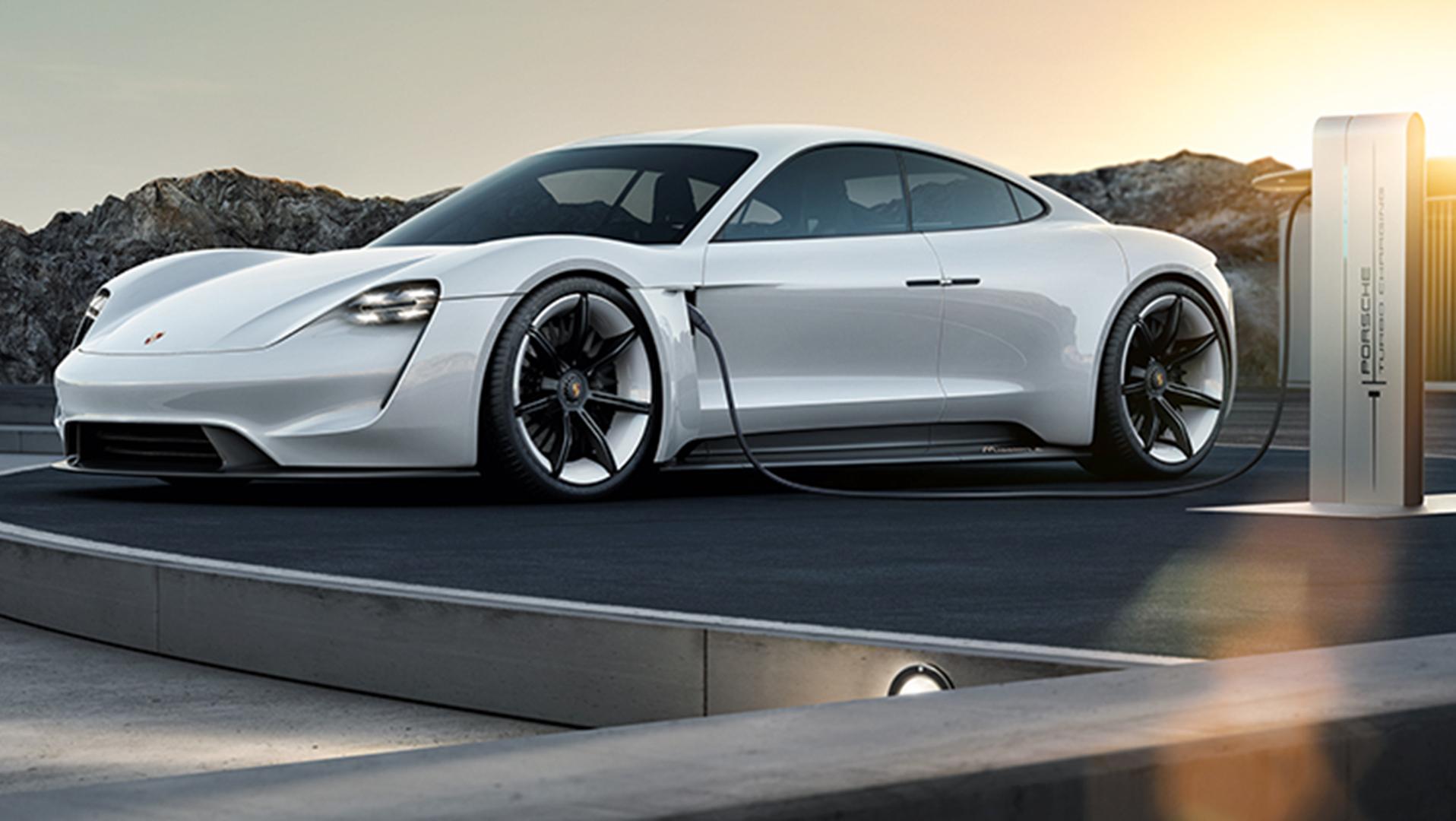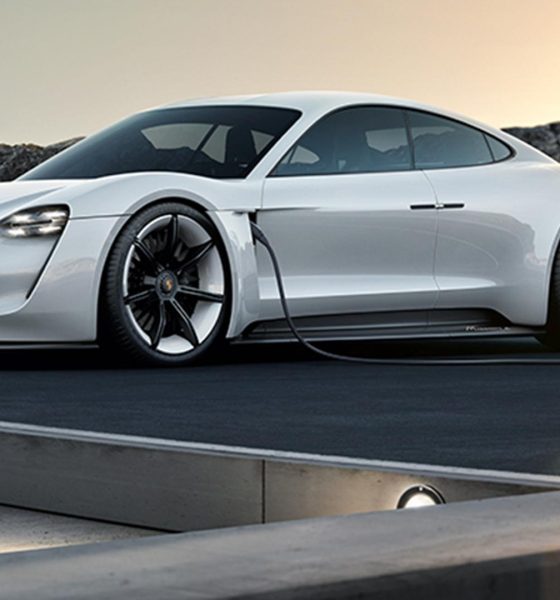

News
Porsche expands plans for dealership-based charging system ahead of Taycan’s release
The production version the Porsche Taycan is yet to be unveiled, but plans for the vehicle’s rollout are already underway. In a recent announcement, Porsche noted that it is increasing the planned rollout of high-speed chargers in the United States to more than 700, an increase of roughly 40%. The installation of around 200 of these rapid chargers is expected to be covered by dealers themselves.
The cost of the rapid chargers is quite substantial. Porsche, for one, estimates that retailers would likely have to invest around $300,000 to $400,000 per store on average for the installation of the EV charging system. In a statement to Automotive News, Porsche Cars North America CEO Klaus Zellmer admitted that the financial weight of the fast chargers would be heavy for dealers. Zellmer further warned that the payoff for investments in the charging system would probably take a long time.
“The financial ask of dealers is actually quite a heavy investment, and a payoff could take a while. It’s typical, if you’re an entrepreneur, that the investment doesn’t pay off within the first one-two-three years. It’s a long-term investment,” the Porsche executive said.
While Porsche retailers in the United States would carry some of the weight of the company’s expanding electrification initiatives, such changes are deemed necessary. Porsche, after all, is on a steady path towards electrification, with the company recently noting that it would be completely discontinuing its diesel lineup. By 2025, Porsche expects 50% of its vehicles to be either full electric, or at least electrified. Thus, one way or another, Porsche’s dealerships would have to embrace electric cars in the coming years.
This is why it is pertinent for the company to start investing in a rapid charging system. The Porsche Taycan is only the first all-electric vehicle from the company, and it is set to be followed by a series of other pedigreed zero-emissions cars like the Mission E Cross Turismo. Zellmer noted that ultimately, the company has to “establish the tech prerequisites to show what the car can do, which first for customers is charging.”
Todd Blue, CEO of IndiGO Auto Group, which operates three Porsche stores in Houston, St. Louis, and Rancho Mirage, CA, noted that the legacy carmaker could consider allowing smaller dealerships to lease the rapid chargers through Porsche Financial Services. This was echoed by Porsche exec Robert DiStanislao, who noted that the investment in electric car chargers is something that needs to be done.
“More than likely we’ll be subsidizing these ports. We have to make sure that these cars are properly charged upon demo. You don’t get a second chance to make a first impression,” he said.
Porsche notes that dealers will be given a choice whether to charge fees for the fast chargers or not. That said, DiStanislao pointed out that on-site rapid chargers would ultimately create sales and service opportunities for the company’s dealers.
“We want customers in our showrooms. We want them to see all the models,” DiStanislao stated.
In order to further prepare for the Taycan’s arrival, Porsche is also looking into partnering with third-party networks that are already active in the United States. Among thee are Electrify America, ChargePoint, and EVgo, as a means to augment its upcoming charging network. By the end of 2018, Porsche is looking to secure a deal with at least one third-party EV charging provider.

News
Tesla FSD fleet is nearing 7 billion total miles, including 2.5 billion city miles
As can be seen on Tesla’s official FSD webpage, vehicles equipped with the system have now navigated over 6.99 billion miles.

Tesla’s Full Self-Driving (Supervised) fleet is closing in on almost 7 billion total miles driven, as per data posted by the company on its official FSD webpage.
These figures hint at the massive scale of data fueling Tesla’s rapid FSD improvements, which have been quite notable as of late.
FSD mileage milestones
As can be seen on Tesla’s official FSD webpage, vehicles equipped with the system have now navigated over 6.99 billion miles. Tesla owner and avid FSD tester Whole Mars Catalog also shared a screenshot indicating that from the nearly 7 billion miles traveled by the FSD fleet, more than 2.5 billion miles were driven inside cities.
City miles are particularly valuable for complex urban scenarios like unprotected turns, pedestrian interactions, and traffic lights. This is also the difference-maker for FSD, as only complex solutions, such as Waymo’s self-driving taxis, operate similarly on inner-city streets. And even then, incidents such as the San Francisco blackouts have proven challenging for sensor-rich vehicles like Waymos.
Tesla’s data edge
Tesla has a number of advantages in the autonomous vehicle sector, one of which is the size of its fleet and the number of vehicles training FSD on real-world roads. Tesla’s nearly 7 billion FSD miles then allow the company to roll out updates that make its vehicles behave like they are being driven by experienced drivers, even if they are operating on their own.
So notable are Tesla’s improvements to FSD that NVIDIA Director of Robotics Jim Fan, after experiencing FSD v14, noted that the system is the first AI that passes what he described as a “Physical Turing Test.”
“Despite knowing exactly how robot learning works, I still find it magical watching the steering wheel turn by itself. First it feels surreal, next it becomes routine. Then, like the smartphone, taking it away actively hurts. This is how humanity gets rewired and glued to god-like technologies,” Fan wrote in a post on X.
News
Tesla starts showing how FSD will change lives in Europe
Local officials tested the system on narrow country roads and were impressed by FSD’s smooth, human-like driving, with some calling the service a game-changer for everyday life in areas that are far from urban centers.

Tesla has launched Europe’s first public shuttle service using Full Self-Driving (Supervised) in the rural Eifelkreis Bitburg-Prüm region of Germany, demonstrating how the technology can restore independence and mobility for people who struggle with limited transport options.
Local officials tested the system on narrow country roads and were impressed by FSD’s smooth, human-like driving, with some calling the service a game-changer for everyday life in areas that are far from urban centers.
Officials see real impact on rural residents
Arzfeld Mayor Johannes Kuhl and District Administrator Andreas Kruppert personally tested the Tesla shuttle service. This allowed them to see just how well FSD navigated winding lanes and rural roads confidently. Kruppert said, “Autonomous driving sounds like science fiction to many, but we simply see here that it works totally well in rural regions too.” Kuhl, for his part, also noted that FSD “feels like a very experienced driver.”
The pilot complements the area’s “Citizen Bus” program, which provides on-demand rides for elderly residents who can no longer drive themselves. Tesla Europe shared a video of a demonstration of the service, highlighting how FSD gives people their freedom back, even in places where public transport is not as prevalent.
What the Ministry for Economic Affairs and Transport says
Rhineland-Palatinate’s Minister Daniela Schmitt supported the project, praising the collaboration that made this “first of its kind in Europe” possible. As per the ministry, the rural rollout for the service shows FSD’s potential beyond major cities, and it delivers tangible benefits like grocery runs, doctor visits, and social connections for isolated residents.
“Reliable and flexible mobility is especially vital in rural areas. With the launch of a shuttle service using self-driving vehicles (FSD supervised) by Tesla in the Eifelkreis Bitburg-Prüm, an innovative pilot project is now getting underway that complements local community bus services. It is the first project of its kind in Europe.
“The result is a real gain for rural mobility: greater accessibility, more flexibility and tangible benefits for everyday life. A strong signal for innovation, cooperation and future-oriented mobility beyond urban centers,” the ministry wrote in a LinkedIn post.
News
Tesla China quietly posts Robotaxi-related job listing
Tesla China is currently seeking a Low Voltage Electrical Engineer to work on circuit board design for the company’s autonomous vehicles.

Tesla has posted a new job listing in Shanghai explicitly tied to its Robotaxi program, fueling speculation that the company is preparing to launch its dedicated autonomous ride-hailing service in China.
As noted in the listing, Tesla China is currently seeking a Low Voltage Electrical Engineer to work on circuit board design for the company’s autonomous vehicles.
Robotaxi-specific role
The listing, which was shared on social media platform X by industry watcher @tslaming, suggested that Tesla China is looking to fill the role urgently. The job listing itself specifically mentions that the person hired for the role will be working on the Low Voltage Hardware team, which would design the circuit boards that would serve as the nervous system of the Robotaxi.
Key tasks for the role, as indicated in the job listing, include collaboration with PCB layout, firmware, mechanical, program management, and validation teams, among other responsibilities. The role is based in Shanghai.
China Robotaxi launch
China represents a massive potential market for robotaxis, with its dense urban centers and supportive policies in select cities. Tesla has limited permission to roll out FSD in the country, though despite this, its vehicles have been hailed as among the best in the market when it comes to autonomous features. So far, at least, it appears that China supports Tesla’s FSD and Robotaxi rollout.
This was hinted at in November, when Tesla brought the Cybercab to the 8th China International Import Expo (CIIE) in Shanghai, marking the first time that the autonomous two-seater was brought to the Asia-Pacific region. The vehicle, despite not having a release date in China, received a significant amount of interest among the event’s attendees.








